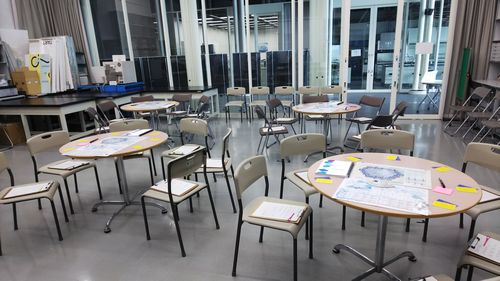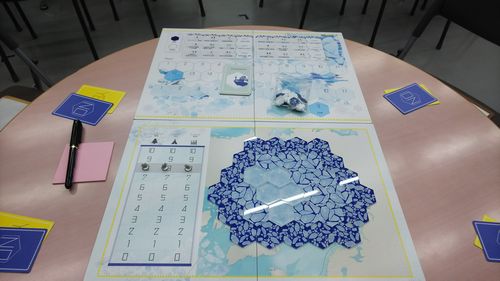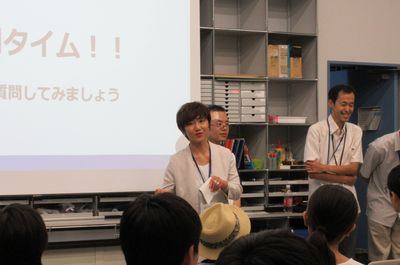No.041 - How the board game “The Arctic” was born
How the board game “The Arctic” was born
Were you aware that sea ice in the Arctic Ocean has been decreasing rapidly in large volumes over the past several decades? Ice floats in the Arctic Ocean throughout the year. In the winter, the sea ice becomes larger and thicker, while it partially melts and reduces in the summer. In this way, the ice continually changes its form. The sea ice area during the summer has been reduced by one-third in the last 35 years. Moreover, worst-case scenarios from simulations indicate that all sea ice in the Arctic will decrease and disappear during a single summer period by the 2040s. It is a global task to understand what kinds of changes are taking place at the Arctic as well as the impact these changes will have on humanity in order to consider the sustainable utilization of Arctic resources.
As part of the Arctic Challenge for Sustainability project, or ArCS, various researchers in the fields of natural sciences and humanities have sought to understand the environmental and climate changes in the Arctic area and the effect that these changes have on the climate and the ecosystem, and the impact these changes have on human life and economies. As a project subsidized since 2015 by the Japanaese Ministry of Education, Culture, Sports, Science and Technology, ArCS was launched with the leadership of three institutes—the National Institute of Polar Research, the Japan Agency for Marine-Earth Science and Technology, and Hokkaido University.
To share the fruits of the research widely with the public, and to create an opportunity for many to reflect on the environmental issues, ArCS and the National Museum of Emerging Science and Innovation, or Miraikan, have developed a learning tool, the board game “The Arctic” (Photo 2).
In this game, every time the sea ice decreases, various events take place such as environmental pollution, opening of the Northern Sea Route, resource development, and natural disasters. Each player is assigned a role such as a diplomat, developer, indigenous person, researcher, and so on, with its own mission. To fulfill the mission, the players must develop resources, conduct research, enact laws, and take action in the game.
I participated in developing this game as a Liberal Arts Communicator of the National Institutes for the Humanities and a cultural anthropologist specializing in Siberia. First, all game developers held a discussion to determine what kinds of events will take place and what types of research or actions are necessary for each event. Simple explanations were then drafted for each item. The explanations are included in the event book used while playing the game. The players can refer to the book when they consider and make decisions to fulfill their assigned roles.
The events cover phenomena that are occurring in reality or those that could potentially cause problems in the future. Initially, the game consisted of many issues related to the natural sciences. This is because researchers in the natural sciences did not adequately understand the impact of Arctic ice reduction on society and culture, nor did they understand the necessity to resolve problems on these fronts. To address this, at the meetings, a political scientist and I presented that the environmental and the climate changes taking place in the Arctic are having an enormous impact on the economy, international politics, and the lives of the indigenous people. As a result, we succeeded in increasing the number of items in the game related to society and culture. Drawing on the knowledge I have gained in my fieldwork in Siberia thus far, I pointed out that climate change would kill a large number of reindeer, reduce the periods during which rivers frozen in the winter can be used as roads, trigger floods, and shrink the areas in which indigenous people can live. In the end, these were integrated as events in the board game.
In the process of developing this board game, I became aware that communication from the standpoint of an anthropologist is effective not just towards the general society, but also towards those in other academic fields and researchers in the natural sciences. My role as a liberal arts communicator that bridges the researchers in the humanities/social sciences and the natural sciences has proven to be effective for sharing the fruits of interdisciplinary research like ArCS. In addition, I believe that playing the game will give an opportunity for players to consider the impact of climate change on the Arctic environment as their own social problems, because the game was developed through the input of researchers in the natural science and humanities/social sciences.

Photo 1: At the workshop venue (photo: Oishi at the National Museum of Emerging Science and Innovation on August 8, 2019)

Photo 2: The board game “The Arctic” (photo: Oishi at the National Museum of Emerging Science and Innovation on August 8, 2019)
Photo 3: ArCS poster panels at the entrance of the venue (photo: Oishi at the National Museum of Emerging Science and Innovation on August 8, 2019)

Yuka Oishi, Liberal Arts Communicator, National Institutes for the Humanities / Project Assistant Professor, National Museum of Ethnology
Oishi received her PhD in Social Anthropology from the Graduate School of Humanities, Tokyo Metropolitan University in 2018. She was a postdoctoral fellow of the Japan Society for the Promotion of Science at the Center for Northeast Asian Studies, Tohoku University before assuming her current position. Oishi’s research interests are environmental changes in the Arctic and human society, subsistence complex in Siberia, and the culture of furs.
Related Event
Board game workshop - ‘The Arctic': Let's think about the Arctic environmental change!
Date and time: Thursday, August 8, 2019
(1) 13:30-15:00
(2) 15:30-17:00
Venue: Science Workshop, Third Floor, National Museum of Emerging Science and Innovation
Organizers: National Museum of Emerging Science and Innovation, Arctic Challenge for Sustainability Project (ArCS)
